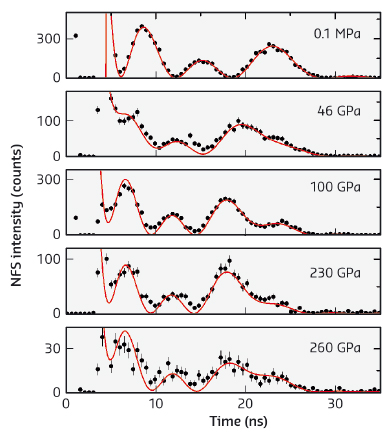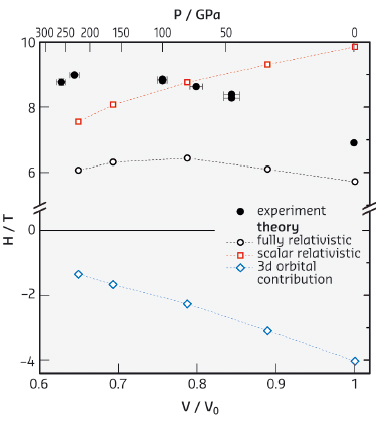- Home
- Users & Science
- Scientific Documentation
- ESRF Highlights
- ESRF Highlights 2014
- Dynamics and extreme conditions
- Hyperfine splitting and room-temperature ferromagnetism of Ni at multimegabar pressure
Hyperfine splitting and room-temperature ferromagnetism of Ni at multimegabar pressure
High pressure generally leads to the suppression of ordered magnetism in the solid state. The critical pressure where magnetism disappears depends on the material. Here we observed ferromagnetism in Ni metal at room temperature up to 260 GPa, the highest pressure where magnetism has been reported.
The critical pressure at which a material becomes non-magnetic is of importance for the fundamental understanding of the origin of its magnetism. In particular, this is important for simple 3d-transition metals Fe, Co and Ni due to their technological use. Fe and Co become nonmagnetic above 16 [1] and 120 [2] GPa, respectively. In these cases, however, the collapse of ferromagnetism is associated with structural transitions of the crystal structure. In contrast for Ni, no structural transition is observed at least up to 200 GPa [3]. Thus, Ni is a good candidate to study solely the effect of pressure on the magnetic properties. It was shown recently by X-ray absorption spectroscopy that Ni stays ferromagnetic up to 200 GPa [3]. Theoretical calculation so far did not predict the critical pressure at which the magnetic moment is quenched. The calculations show that the ferromagnetic state is persistent up to 300 GPa at 0 K [4] and the Curie temperature is expected to decrease to room temperature at about 160 GPa [5] or at 300 GPa [6].
 |
|
Fig. 79: Time evolution of the nuclear forward scattering for Ni measured at room temperature and different pressures. The solid lines show the best fit to the data. The oscillation period of the signal is inversely proportional to the magnetic hyperfine splitting. |
In this work, the magnetic properties of Ni metal under high pressure were investigated by nuclear forward scattering (NFS), using the 67.4 keV nuclear transition in 61Ni. The measurements performed at beamline ID18 revealed the presence of magnetic hyperfine splitting of Ni metal at room temperature up to 260 GPa (see Figure 79), which confirm that Ni stays ferromagnetic up to this pressure. The magnetic hyperfine field shows a peculiar pressure dependence, reported in Figure 80. It slowly increases up to its maximum value around 225 GPa and then decreases towards higher pressures. This result seems to be in contradiction to the observed and theoretically predicted continuous decrease of the magnetic moment, which is supposed to be proportional to the magnetic hyperfine field. The theoretical explanation of this behaviour reveals the importance of relativistic effects. In fact, the hyperfine field consists of two main contributions of different signs: a positive contribution due to the Fermi contact interaction and a negative contribution due to the orbital magnetic moment of the 3d electrons induced by spin-orbit coupling. The magnitude of both contributions decreases with pressure, similar to the magnetic moment but with different slopes. Thus, the sum of the two contributions, that determines the total hyperfine field, increases up to 100-180 GPa, reproducing well the experimentally observed behaviour.
 |
|
Fig. 80: Pressure dependence of the hyperfine magnetic field in Ni from experiment and theory, calculated using fully relativistic ab initio calculations. Positive and negative contributions to the calculated field are shown as scalar relativistic calculations (mainly due to the Fermi contact interaction) and 3d orbital contribution. |
This work demonstrates a breakthrough in the technique that enables magnetism to be studied in Ni containing compounds at high and ultra-high pressures. The efficiency of the method significantly benefits from the application of high pressure because of the hardening of the material and, consequently, a substantial increase in the Lamb-Mössbauer factor. Thus, the highest pressure observed in this work is not limited by the NFS technique but by the mechanical stability of the diamond anvil cells used. Recent advances in high pressure technology [7] as well as the decrease of the X-ray source size with the future upgrade of the ESRF would allow the technique to study Ni and Ni containing compounds at pressures even above 500 GPa.
Principal publication and authors
I. Sergueev (a), L. Dubrovinsky (b), M. Ekholm (c), O.Yu. Vekilova (d), A.I. Chumakov (e), M. Zajac (e), V. Potapkin (e,b), I. Kantor (e), S. Bornemann (f), H. Ebert (f), S.I. Simak (d), I.A. Abrikosov (d) and R. Rüffer (e), Physical Review Letters 111, 157601 (2013).
(a) Deutsches Elektronen-Synchrotron, D-22607 Hamburg (Germany)
(b) Bayerisches Geoinstitut, Universität Bayreuth (Germany)
(c) Swedish e-Science Research Centre (SeRC), Department of Physics, Chemistry and Biology (IFM), Linköping University (Sweden)
(d) Department of Physics, Chemistry and Biology (IFM), Linköping University (Sweden)
(e) ESRF
(f) Department of Chemistry, Ludwig-Maximilians-Universität München (Germany)
References
[1] O. Mathon et al., Phys. Rev. Lett. 93, 255503 (2004).
[2] R. Torchio et al., Phys. Rev. B 84, 060403 (2011).
[3] R. Torchio et al., Phys. Rev. Lett. 107, 237202 (2011).
[4] T. Jarlborg, Physica C 385, 513 (2003).
[5] S. Shang et al., J. Appl. Phys. 108, 123514 (2010).
[6] V. G. Tissen, Sov. Phys. Solid State 25, 11 (1983).
[7] L. Dubrovinsky et al., Nature Communications 3, 1163 (2012).



